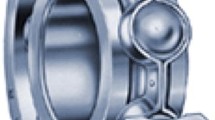Abstract
Accurate equipment remaining useful life prediction is critical to effective condition based maintenance for improving reliability and reducing overall maintenance cost. In this paper, an artificial neural network (ANN) based method is developed for achieving more accurate remaining useful life prediction of equipment subject to condition monitoring. The ANN model takes the age and multiple condition monitoring measurement values at the present and previous inspection points as the inputs, and the life percentage as the output. A function generalized from the Weibull failure rate function is used to fit each condition monitoring measurement series for a failure history, and the fitted measurement values are used to form the ANN training set so as to reduce the effects of the noise factors that are irrelevant to the equipment degradation. A validation mechanism is introduced in the ANN training process to improve the prediction performance of the ANN model. The proposed ANN method is validated using real-world vibration monitoring data collected from pump bearings in the field. A comparative study is performed between the proposed ANN method and an adapted version of a reported method, and the results demonstrate the advantage of the proposed method in achieving more accurate remaining useful life prediction.
Similar content being viewed by others
References
Banjevic D., Jardine A. K. S., Makis V. (2001) A control-limit policy and software for condition-based maintenance optimization. INFOR 39: 32–50
Dong M., He D. (2007a) A segmental hidden semi-Markov model (HSMM)-based diagnostics and prognostics framework and methodology. Mechanical Systems and Signal Processing 21(5): 2248–2266
Dong M., He D. (2007b) Hidden semi-Markov model-based methodology for multi-sensor equipment health diagnosis and prognosis. European Journal of Operational Research 178(3): 858–878
Dong M., He D., Banerjee P., Keller J. (2006) Equipment health diagnosis and prognosis using hidden semi-Markov models. International Journal of Advanced Manufacturing Technology 30(7–8): 738–749
Gebraeel N., Lawley M. A. (2008) A neural network degradation model for computing and updating residual life distributions. IEEE Transactions on Automation Science and Engineering 5(1): 154–163
Gebraeel N., Lawley M. A., Liu R. (2004) Residual life predictions from vibration-based degradation signals: A neural network approach. IEEE Transactions on Industrial Electronics 51(3): 694–700
Huang R. Q., Xi L. F., Li X. L., Liu C. R., Qiu H., Lee J. (2007) Residual life predictions for ball bearings based on self-organizing map and back propagation neural network methods. Mechanical Systems and Signal Processing 21(1): 193–207
Inman D. J., Farrar C. R., Lopes V. (2005) Damage prognosis: For aerospace, civil and mechanical systems. Wiley, NY
Jardine A. K. S., Lin D. M., Banjevic D. (2006) A review on machinery diagnostics and prognostics implementing condition-based maintenance. Mechanical Systems and Signal Processing 20(7): 1483–1510
Kacprzynski, G. J., Roemer, M. J., Modgil, G., Palladino, A., & Maynard, K. (2002). Enhancement of physics-of-failure prognostic models with system level features. In Proceedings of the 2002 IEEE aerospace conference, Big Sky, MT, USA.
Kuo W., Zuo M. J. (2003) Optimal reliability modeling: Principles and applications. Wiley, Hoboken
Lee J., Ni J., Djurdjanovic D., Qiu H., Liao L. T. (2006) Intelligent prognostics tools and e-maintenance. Computers in Industry 57: 476–489
Levitin G. (2005) Universal generating function in reliability analysis and optimization. Springer-Verlag, London
Levitin G., Lisnianski A., Ben Haim H., Elmakis D. (1998) Redundancy optimization for series-parallel multistate systems. IEEE Transactions on Reliability 47(2): 165–172
Li C. J., Lee H. (2005) Gear fatigue crack prognosis using embedded model, gear dynamic model and fracture mechanics. Mechanical Systems and Signal Processing 19: 836–846
Liao H. T., Elsayed E. A., Chan L. Y. (2006) Maintenance of continuously monitored degrading systems. European Journal of Operational Research 175(2): 821–835
Lin D., Banjevic D., Jardine A. K. S. (2006) Using principal components in a proportional hazards model with applications in condition-based maintenance. Journal of the Operational Research Society 57: 910–919
Makis V., Jardine A. K. S. (1992) Optimal replacement in the proportional hazards model. INFOR 30: 172–183
Marble, S., & Morton, B. P. (2006). Predicting the remaining life of propulsion system bearings. In Proceedings of the 2006 IEEE aerospace conference, Big Sky, MT, USA.
Rojas R. (1996) Neural networks: A system introduction. Springer, Berlin
Stevens, B. (2006). EXAKT reduces failures at Canadian Kraft Mill. http://www.omdec.com.
Tian, Z., & Zuo, M. J. (2009). Health condition prognostics of gears using a recurrent neural network approach. In Proceedings of the reliability and maintainability symposium, Fort Worth, TX, USA.
Tse P. W., Atherton D. P. (1999) Prediction of machine deterioration using vibration based fault trends and recurrent neural networks. Journal of Vibration and Acoustics, Transactions of ASME 121: 355–362
Vachtsevanos G., Lewis F. L., Roemer M., Hess A., Wu B. (2006) Intelligent fault diagnosis and prognosis for engineering systems. Wiley, NY
Wu S. J., Gebraeel N., Lawley M. A., Yih Y. (2007) A neural network integrated decision support system for condition-based optimal predictive maintenance policy. IEEE Transactions on Systems Man and Cybernetics Part A: Systems and Humans 37(2): 226–236
Author information
Authors and Affiliations
Corresponding author
Rights and permissions
About this article
Cite this article
Tian, Z. An artificial neural network method for remaining useful life prediction of equipment subject to condition monitoring. J Intell Manuf 23, 227–237 (2012). https://doi.org/10.1007/s10845-009-0356-9
Received:
Accepted:
Published:
Issue Date:
DOI: https://doi.org/10.1007/s10845-009-0356-9




